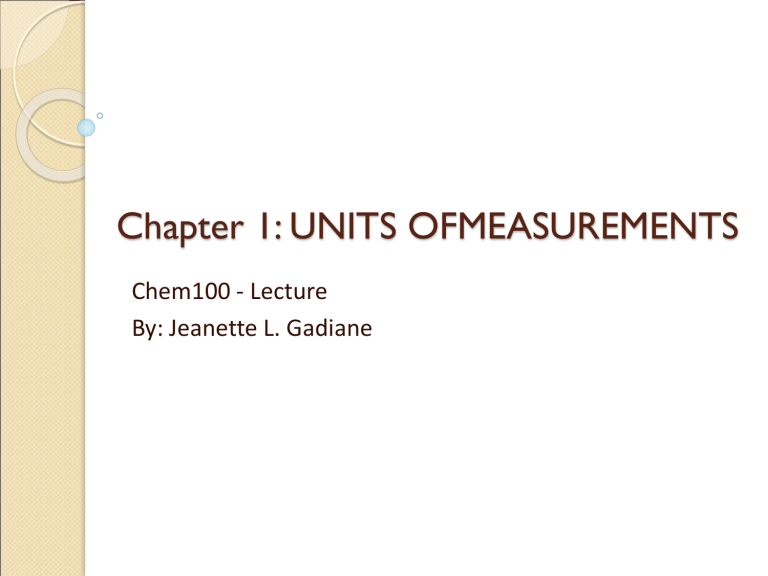
Chapter 1: UNITS OFMEASUREMENTS Chem100 - Lecture By: Jeanette L. Gadiane Objectives At the end of the chapter, the students should be able to: Distinguish SI system of measurement from English system Determine figures which are significant Round-off quantities correctly Convert from one system to the another using factor-label method Interconvert temperatures in the Fahrenheit, Celsius and Kelvin scales Introduction Almost everything we own – clothes, house, food, vehicle- is manufactured with measured parts, sold in measured amounts, and paid for with measured currency! A. The International System of Units It is a modified system of measurement based in metric units, that is, using the decimals or by powers of 10. There are seven fundamental units or base units in SI system, each of which is identified with a physical quantity.These are the length, mass, time, electrical current, temperature, amount of substance, and luminous intensity. All other units are derived units which are combinations of these seven base units. SI Base Units BASE QUANTITY NAME OF UNIT SYMBOL Length Mass Time Electrical current Temperature Amount of substance Luminous intensity Meter Kilogram Second Ampere Kelvin Mole m kg s A K mol Candela cd Prefixes Used with SI Units PREFIXES SYMBOL TeraT GigaG Mega- M Kilok Hecto h Deka da Decid Centi- c Millim Micro- μ Nano- n Picop MEANING EXPONENTIAL 1,000,000,000,000, 1,000,000,000, 1,000,000, 1,000, 100 10 1012 109 106 103 102 101 1/10, 1/100, 1/1,000, 1/1,000,000, 1/1,000,000,000, 1/1,000,000,000,000 10-1 10-2 10-3 10-6 10-9 10-12 Commonly Used SI Units in the Study of Chemistry Length Meter (m) – SI base unit Standard meter is the distance light travels in a vacuum in 1/299,792,458 second Biological cells are often measured in micrometers ( 1 μm = 10-6 m) Atomic-sized scale, nanometer and picometer are used ( 1 nm = 10-9 m; 1pm = 10-12 m) Volume Cubic meter (m3) – SI unit liter (L) and milliliter (mL) – the most important volumes used in chemistry cubic decimeter (dm3) – used in medical field 1 L = 1 dm3 = 10-3 m Mass Mass - refers to the quantity of matter it contains Weight – the force exerted by a gravitational field : therefore mass is constant while weight varies! on an object kilogram (kg) – is the SI unit - Its standard is a physical object – the platinum-iridium cylinder kept in france Density Density = mass/volumea derived unit kg/m3 - SI unit of density g/L (g/dm3) or g/mL (g/cm3) – commonly used in Chemistry B. SIGNIFICANT FIGURES Significant figures – are the figures that are both certain and uncertain one. Significant Figures Figure TA 1.2 Copyr ight © 2001 T he McGr aw- Hill Com panies, Inc. Permission required for reproduction or display. The more significant figures in a quantity, the more accurate is the measurement. Rules in DeterminingSignificant Figures Determining which digits are significant: 1. All non-zero digits are significant 2. All zeros between a non-zero digits are significant 3. All zeros to the right of a non-zero digit after the decimal point are significant 4. In the absence of decimal point, significant figures vary Sample Problems How many significant figure are there in: 1. 2. 3. 435 m 0.0120 L 27,075 g Seat work 1. 0.0030 L 2. 0.1044 g 3. 53,069 mL 4. 2.00 x 103 cm 5. 57,600 s Rules for Significant Figures in Answers For multiplication and division: The answer contains the same number of significant figures with the measurements that contains the fewest number of significant figures. Ex. Volume (cm3) = 9.2 cm x 6.8 cm x 0.3744 cm= 23 cm3 Least no .of significant figures For addition and subtraction: The answer has the same number of decimal places with the measurement with the fewest decimal places. Ex. Volume (mL) = 83.5 mL + 23.28 mL = 106.8 mL least no. of decimal places Rules for Rounding Off 1. If the digit removed is more than 5, the preceding number is increased by 1. Ex. 5.379 rounds to 5.38 for three s.f., and 5.4 for four s.f. 2. If the digit removed is less than 5, the preceding number is unchanged. Ex. 0.2413 round to 0.241 for three s.f., 0.24 for two s.f. 3. If the digit removed is 5, the preceding number is increased by 1. 4. Always carry one or two additional significant figures through a multi-step calculation and round off the final answer only. Round-off the following: 1. The product of 12.2 x 4.0230 2. The sum of 12.2 + 4.0230 3. The sum of 1.2 x 10-3 + 1.4 x 10-2 Accuracy versus Precision Accuracy refers to the proximity of a measurement to the true value of a quantity. Precision refers to the proximity of several measurements to each other. Calculations... Factor Label method Metric-Metric Conversion English- SI Conversion Factors Common SI-English Equivalents Examples Convert the following quantities: 1) 1500 mL = L 2) 4.67 x 104 μg = g 3) 4) 5) 6) 7) 8) 9) 10) 3.15 x 10-5 Mm = km 2.10 x 106 pm = μm 0.89 g = mg 3.45 cm = ft 0.0678 fl oz = mL 45 g = lb 1.5 qt = mL 0.075 mi = m C. Temperatures Heat – the energy in transfer Temperature – the hotness or coldness of a body. Thermometer – a device used to measure the temperature of a certain body. Temperature Scales Celsius (oC) Fahrenheit (oF) Kelvin (K) Temperature Scales Fahrenheit (F): freezing point of water is 32°F and the boiling point of water is 212°F Celsius (C): freezing point of water is 0°C and boiling point of water is 100°C Kelvin (K): zero is the lowest possible temperature; also called the absolute scale ◦ degree is the same size as Celsius degree ◦ K = °C + 273 Fig. 1.6, p.11 Formulas 9 °F = _ °C + 32 5 K = oC + 273 5 °C = _ (°F - 32) 9 Examples Convert the following temperatures: 1. 40.5 oC to oF 2. 124 oF to oC 3. 205.9 oF to K 4. A child has a body temperature of 38.7oC. a. If the normal body temperature is 98.6oF, does a child has a fever? b. What is the child’s temperature in Kelvin? Density and Specific Gravity Calculations Density – mass of the object divided by its volume. D = M/V It is used to characterize or identify a substance since its substance has a corresponding unique density. example: during gold rush era, density is used to distinguish a real gold from a “fool’s gold” (pyrite). Examples 1. 2.00 cm3 of aluminum are found to weigh 5.40 g. Calculate the density of aluminum in units of g/cm3. 2. Air has a density of 0.0013 g/mL. What is the mass of 6.0-L sample of air? 3. Calculate the mass in grams of 10.0 mL of mercury if the density of mercury is 13.6 g/mL. 4. Calculate the volume in mL of a liquid that has a density of 1.20 g/mL and a mass of 5.00 g. Exercise 1. The density of ethyl alcohol is 0.789 g/mL at 20oC. Calculate the mass of a 30.0-mL sample. 2. Calculate the volume in mL of 10.0 g of a saline solution that has a density of 1.05 g/mL. Specific Gravity A reference density based on the density of water (1.00 g/mL) at 4oC. Unitless It is measured by a hydrometer (consists of a weighted glass bulb that is inserted into a liquid and allowed to float). Urinometer – a hydrometer used to measure urine samples. density of obj. (g/mL) Specific gravity= density of H2O (g/mL) Application: routine hospital tests including measurement of the specific gravity of urine and blood samples are frequently used as diagnostic tools. Examples 1. The density of ethanol at 20oC is 0.789 g/mL. What is its specific gravity? 2. The specific gravity of a urine sample is 1.016. What is its density in g/mL? 3. The normal range for normal urine specific gravity is 1.010 – 1.030. Given that the a 335.0 cc sample of urine has a mass of 342.6 g, is the urine sample fall within the normal range? 4. The density of dichloromethane (an organic substance), a liquid insoluble water, is 1.33 g/cc. If dichloromethane and water are placed in a separatory funnel, which will be the upper layer?
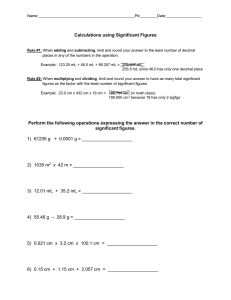

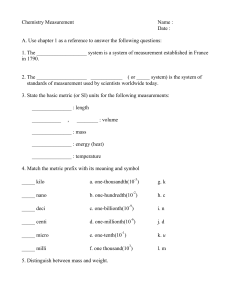

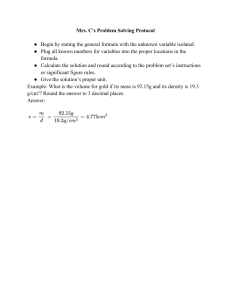
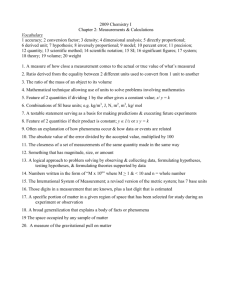
![Temperature Notes [9/22/2015]](http://s3.studylib.net/store/data/006907012_1-3fc2d93efdacd086a05519765259a482-300x300.png)